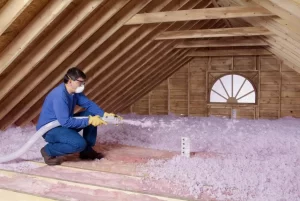Nowadays, houses are constructed using several modern technologies. Therefore, newly constructed buildings require a minimum amount of insulation in walls and attics, however, houses constructed in the olden days may require blown in insulation. This insulation consists of tiny pieces of material that are blown into walls and attics through a long hose. So whenever you think of adding insulation to your home, the image of fiberglass insulation flashes in your mind.
This improves the insulation in attics and helps you save on electricity bills. There are a variety of materials that you can use, This includes styrofoam pellets or loose fiberglass fibers which have become the most common ones. Blow-in insulation is widely considered the best means of adding insulation to existing construction. So, in today’s article, we shall discuss some significant aspects of blown-in insulation. Let’s take a glance!
Some Unknown Facts About Blown in Insulation
As we said earlier, adding insulation in the attic can be exhausting, but once you can do it, the benefit is yours. The specialists can do it by hauling unfaced rolls of fiberglass insulation into an attic and then unrolling them to form an uninterrupted blanket. On the other hand, for wall cavities, blow-in insulation is the only way to improve the R-value of stud cavities. Let us now look into some of the other aspects in detail:
1. Blown-in Insulation fills between existing wall studs and ceiling joists smoothly:
For houses that have been constructed a long time ago, blown-in insulation is the best hassle-free option. This type of insulation can easily seal small gaps and spaces as it settles, filling these sneaky spots where the cold wind would otherwise come in. In addition to creating an insulating blanket, blown insulation helps reduce sound transfer between the outdoors and the indoors. Therefore, no unwanted street noise will disturb your peace at home.
2. Three Main Types Of Blown-in Insulation
Now, if you are wondering about the materials that blown-in insulation comprises, let us shed some light on it. The three most common types of blown-in insulation are loose-fill fiberglass, cellulose, and rock wool, which have their pros and cons. At times, not all types of blown-on insulation provide you with the same kind of thermal value, but in most cases, the result is positive. Let us check out these three types down below:
- Loose-Fill Fiberglass
This light-as-air insulation is manufactured from glass. The specialists heat it to a liquid and then spin it into thin fibers. So, one bag of loose-fill fiberglass will provide a thermal value of R-19 over a 106.6 sq ft area.
- Cellulose
If you are one of the eco-minded homeowners, cellulose is often a popular choice. This is because it’s made from finely shredded recycled cardboard or newspaper. It is also the most common type of blown-in insulation on the market. Moreover, it has the properties to resist mold and fire. This insulation has an average thermal value of R-37.
- Rock wool
People also know it commonly as ‘mineral wool.’ The main component of this type of insulation is blast furnace slag. Moreover, due to its excellent fire resistance, we use rock wool often in fire-prone areas.
3. Blown-In Insulation Are Available At Home Improvement Centers
If you are worrying about where to purchase blown-in insulation, you can get the materials at most lumberyards and home decor stores. However, this is applicable for cellulose and loose-fill fiberglass. If you want to purchase rock wool insulation you have to order it beforehand. Moreover, if you are doing it yourself, you might need a blower which is also available in these places.
4. It Lasts For A Long Time
Installing blown-in insulation is a long-term solution for most homes. However, you might need to replace it at some point in time. According to the sources, these insulations can last up to 20 years and can last a house’s lifespan. But this also means that the installation needs to be perfect. So, under ideal conditions, professional installation, and little or no water damage, the insulation will remain as it is. Among all three materials, fibreglass lasts the longest, lasting around 80 to 100 years. So you can opt accordingly.
Ending Note
So, as we conclude, we can say that blown-in insulation is the best option for houses that have been built for a long time. This is because it is hassle-free and has countless advantages. You can read through the above article to learn some of the significant aspects of blown-in insulation.
For more information, visit Apzo Media





